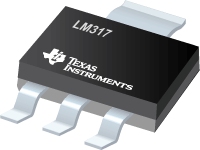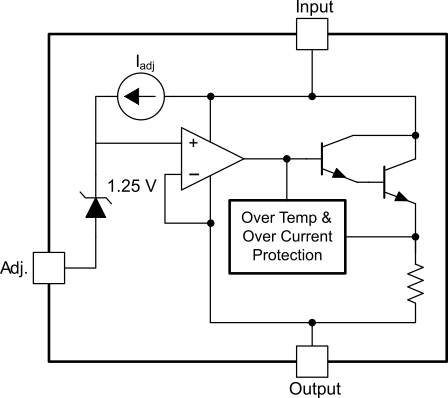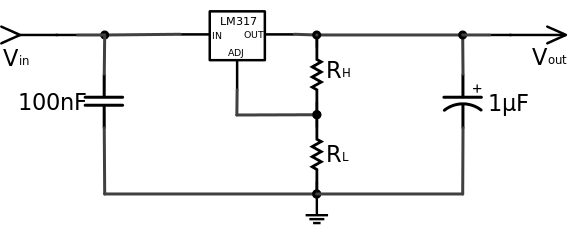LM317是非常常用的可调输出线性稳压器,由美国国家半导体公司的Robert C Dobkin于1976设计的一颗经典器件,与LM317输出正电压相对应的是能够输出负电压的线性稳压器LM337由Robert “Bob” Pease设计

LM317
规格
| 符号 | 参数 | 值 | 单位 |
|---|---|---|---|
| Vout | 1.25 | – 37 | |
| Vin | – Vout | 差别 | |
| TJ | 工作结温范围 | 0 – 125 | °C |
| IO(MAX) | 最大输出电流 | 1.5 | A |
| IL(MIN) | 最小负载电流 | 3.5 mA typical, 12 mA maximum | |
| PD | 功率消耗 | 内部限制 | W [1] |
| RθJA | 结到环境热阻 | 80 | °C/W |
| RθJC | 结壳热阻 | 5 | °C/W |
Without a heat sink with an ambient temperature at 50 ⁰C such as on a hot summer day inside a box, a maximum power dissipation of (TJ-TA)/RθJA = ((125-50)/80) = 0.98 W can be permitted. (A piece of shiny sheet metal of Aluminum with the dimensions 6 x 6 cm and 1.5 mm thick, results in a thermal resistance that permits 4.7 W of heat dissipation[2][3]).
In a constant voltage mode with an input voltage source at VIN at 34 V and a desired output voltage of 5 V, the maximum output current will be PMAX / (VI-VO) = 0.98 / (34-5) = 32 mA.
For a constant current mode with an input voltage source at VIN at 12 V and a forward voltage drop of VF=3.6 V, the maximum output current will be PMAX / (VI - VF) = 0.98 / (12-3.6) = 112 mA.
LM317内部功能框图
工作
As linear regulators, the LM317 and LM337 are used in DC to DC converter applications.
Linear regulators inherently waste as much current as they supply. When this current is multiplied by the voltage difference between input and output, a significant amount of heat results. Therefore the use of an LM317 commonly also requires a heat sink. For large voltage differences, the energy lost as heat can ultimately be greater than that provided to the circuit. This is the trade-off for using linear regulators which are a simple way to provide a stable voltage with few additional components. The alternative is to use a switching voltage regulator which is usually more efficient but has a larger footprint and requires a larger number of associated components.
In packages with a heat-dissipating mounting tab, such as TO-220, the tab is connected internally to the output pin which may make it necessary to electrically isolate the tab or the heat sink from other parts of the application circuit. Failure to do this may cause the circuit to short.
稳压
Schematic of LM317 in a typical voltage regulator configuration, including decoupling capacitors to address input noise and output transients.
The LM317 has three pins: INput, OUTput, and ADJustment. The device is conceptually an op amp with a relatively high output current capacity. The inverting input of the amp is the adjustment pin, while the non-inverting input is set by an internal bandgap voltage reference which produces a stable reference voltage of 1.25 V.
A resistive voltage divider between the output and ground configures the op amp as a non-inverting amplifier so that the voltage of the output pin is continuously adjusted to be a fixed amount, the reference voltage, above that of the adjustment pin. Ideally, this makes the output voltage:
Vout = Vref (1 + RL/RH) Because some quiescent current flows from the adjustment pin of the device, an error term is added:
Vout = Vref (1 + RL/RH) + IQRL To make the output more stable, the device is designed to keep the quiescent current at or below 100µA, making it possible to ignore the error term in nearly all practical cases.[4]
稳流
A constant current source circuit constructed with LM317
The device can be configured to regulate the current to a load, rather than the voltage, by replacing the low-side resistor of the divider with the load itself. The output current is that resulting from dropping the reference voltage across the resistor. Ideally, this is:
Iout = Vref/RH Accounting for quiescent current, this becomes:
Iout = (Vref/RH) + IQ LM317 can also be used to design various other circuits like 0 V to 30 V regulator circuit, adjustable regulator circuit with improved ripple rejection, precision current limiter circuit, tracking pre-regulator circuit, 1.25 V to 20 V regulator circuit with minimum program current, adjustable multiple on-card regulators with single control, battery charger circuit, 50 mA constant current battery charger circuit, slow turn-on 15 V regulator circuit, ac voltage regulator circuit, current-limited 6 V charger circuit, adjustable 4 V regulator circuit, high-current adjustable regulator circuit and many more.
同78xx/79xx系列比较
The LM317 is an adjustable analogue to the popular 78xx fixed regulators. Like the LM317, each of the 78xx regulators is designed to adjust the output voltage until it is some fixed voltage above the adjustment pin (which in this case is labeled “ground”).
The mechanism used is similar enough that a voltage divider can be used in the same way as with the LM317 and the output follows the same formula, using the regulator's fixed voltage for Vref (e.g. 5 V for 7805). However, the 78xx devices' quiescent current is substantially higher and less stable. Because of this, the error term in the formula cannot be ignored and the value of the low-side resistor becomes more critical.[6] More stable adjustments can be made by providing a reference voltage that is less sensitive than a resistive divider to current fluctuations, such as a diode drop or a voltage buffer. The LM317 is designed to compensate for these fluctuations internally, making such measures unnecessary.
The LM337 relates in the same way to the fixed 79xx regulators.



